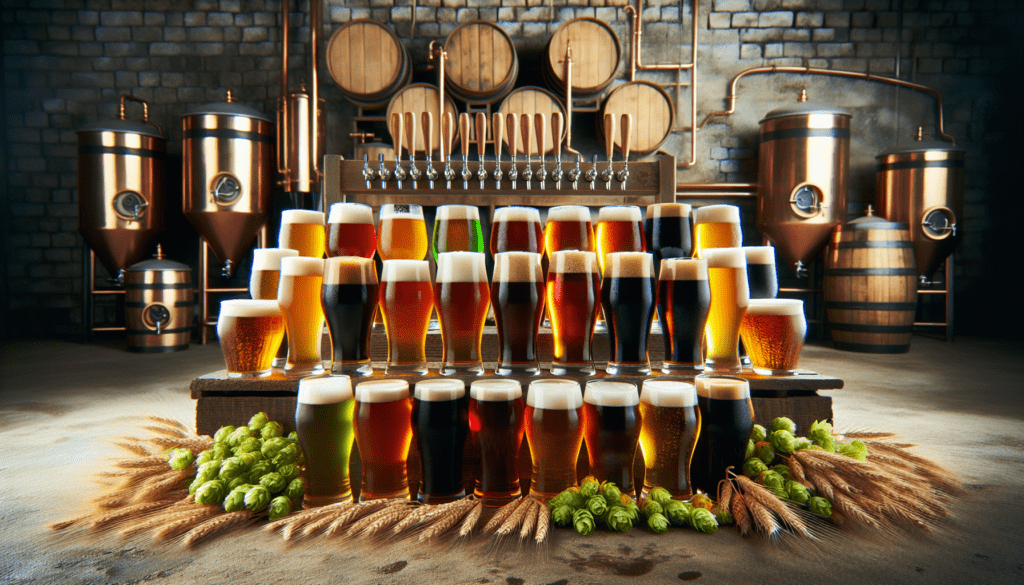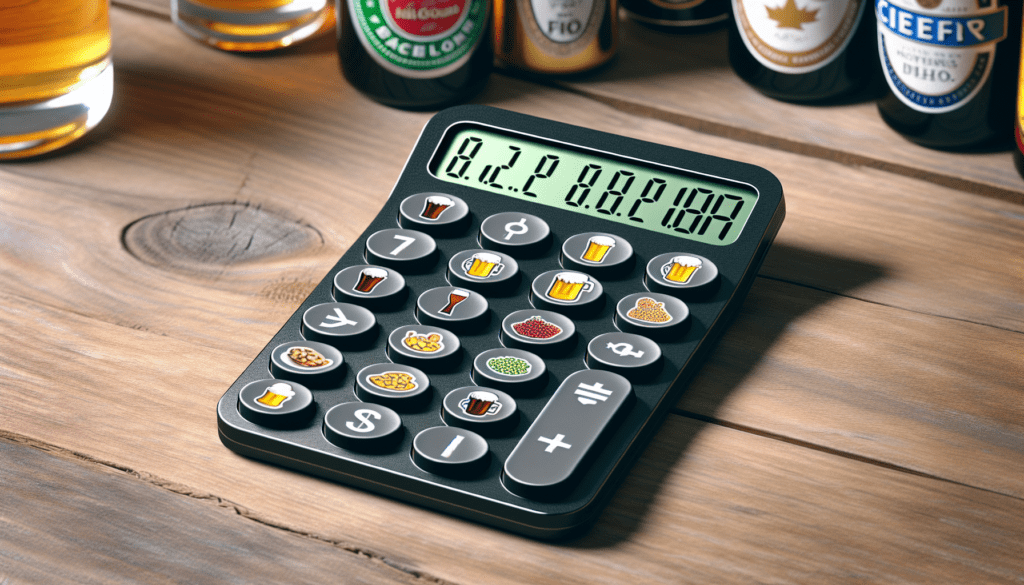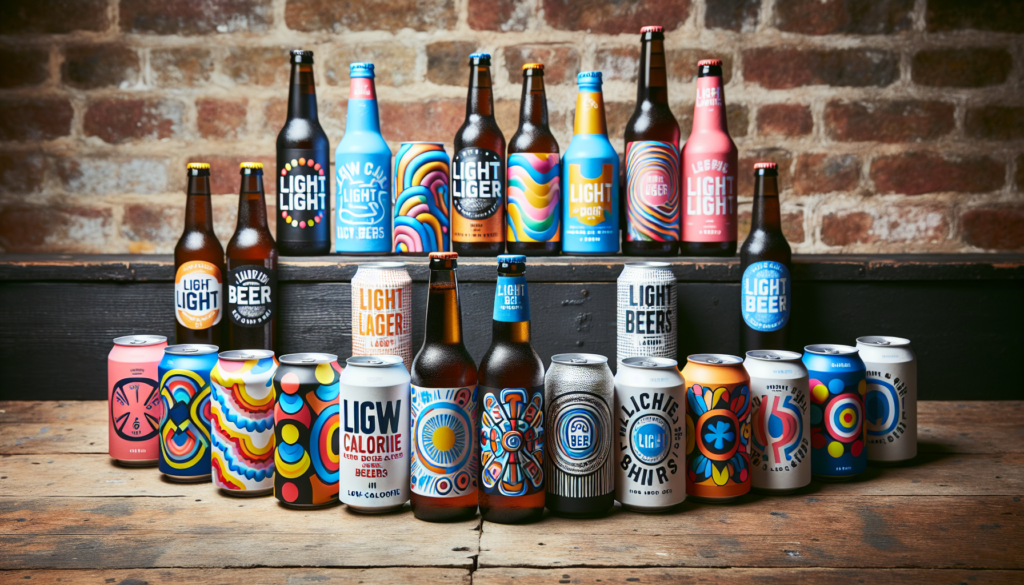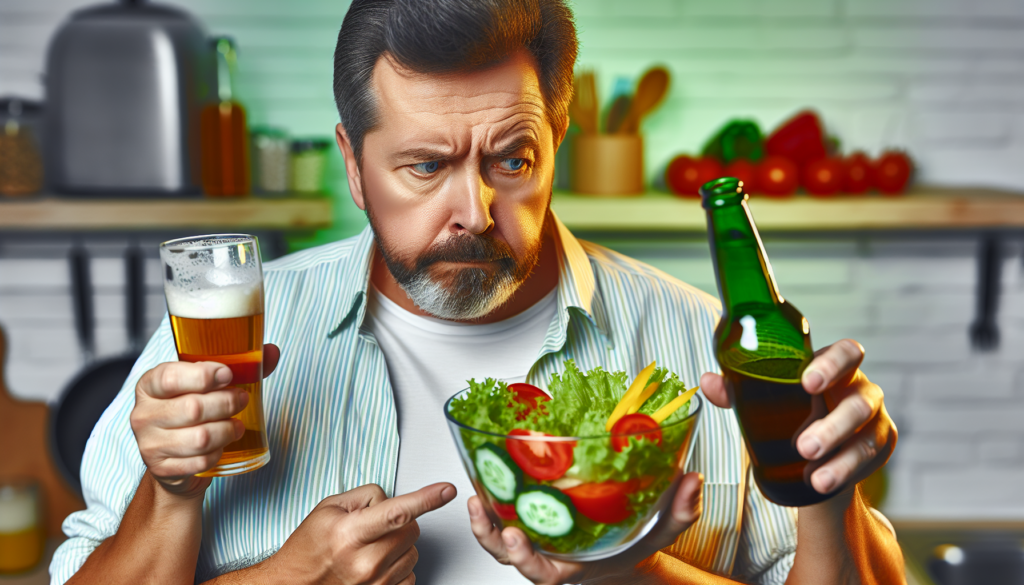Wondering how many calories are in your pint? Discovering the calorie count in your beer is essential, especially if you’re keeping an eye on your diet. Our ‘calories in beer calculator’ is the straightforward tool you need to quickly calculate the caloric content based on the beer’s ABV. No guesswork, just precise figures to help you enjoy your beer responsibly. Read on to find out not only how the calculator works but also what influences the caloric content in your beer. For a comprehensive approach, check out our beer calorie calculator guide to track your intake while still enjoying your favorite brews.
Key Takeaways
Calories in beer are mostly from alcohol and carbs, with higher ABV beers packing more calories. Tools like a Beer Calories Calculator can help you monitor intake.
Beer calorie content varies with the brewing process, ingredients, and beer type. Light beers offer fewer calories, often with minimal flavor compromise.
Managing beer-related calorie intake is crucial for health. This can involve choosing light beers, moderating consumption, and making healthier food choices.
The Secrets of Beer Calories

Beer derives its calories from a mix of alcohol and carbohydrates found in the ingredients, where grains are major contributors. Now, here’s something to ponder – the higher the alcohol content, or Alcohol by Volume (ABV), the higher the calorie intake. In fact, around 60% of beer calories come from alcohol. But that’s not all. Carbohydrates make up about 40% of the calories in beer, with residual sugars remaining after fermentation adding to this calorie count.
The brewing process, including the type and amount of malt used, also influences the caloric contribution of beer. Darker malts and a higher malt content typically hike up the calorie counts. But here’s a silver lining: you can keep track of your beer calories with a handy tool called the beer calories calculator! To estimate the caloric content, you can use the formula ‘calories = ABV% x factor 2.5 x ounces of beer’, which highlights the relationship between ABV and the overall calorie count.
The Role of ABV in Beer Calorie Content
The alcohol content in beer, represented by its Alcohol by Volume (ABV), is a crucial determinant of its calorie content. Each gram of alcohol in beer contains about seven calories, significantly contributing to the total calorie count.
Beers with a higher ABV, such as 8%, typically contain more calories than those with lower ABVs, like 5% ABV beers. The formula for calculating calories from alcohol in beer uses the original and final gravity measures to account for the ABV contribution to total calories. To estimate beer calories, you can multiply the ABV percentage by the abv x factor 2.5 and the number of ounces of beer consumed. Wondering how this works? Hang in there, we’ll get to it!
Carbohydrates Count: Their Impact on Beer’s Caloric Load
Derived from ingredients such as wheat, barley, or malt, the carbohydrate content in beer significantly influences its caloric value. On average, a 12-ounce beer contains 13 grams of carbohydrates, which equate to 52 calories. The carbohydrate level in beer can vary due to the fermentation process and the use of ingredients, with added sugars potentially increasing the carbohydrate content.
To calculate the calories from carbohydrates in beer, a specific formula is used. But remember, properly calculating a beer’s caloric content requires considering both the alcohol and carbohydrates, as each contributes to the total calorie count of the beverage.
Brewing Insights: How Production Affects Calories
A beer’s calorie content is greatly influenced by the brewing process. The quantity of fermentable sugars in the wort and the extent of the fermentation process influence a beer’s alcohol by volume (ABV) and consequently its calorie content.
Craft beers typically have higher calorie contents than their commercial counterparts due to a combination of factors such as higher ABV, less optimized sugar utilization, and the introduction of additional raw ingredients. On the flip side, low-calorie craft beer options like Firestone Walker Flyjack and Deschutes Wowza! maintain a low calorie count while offering distinct flavor profiles.
Light beers cut down calories through techniques including dilution, altering the mashing process, and utilizing enzymes.
Crafting the Perfect Beer Calories Calculator

With an understanding of what contributes to the calories in beer, it’s time to introduce a useful tool to calculate them – the Beer Calories Calculator. This calorie calculator helps users track their caloric intake from alcoholic beverages, supporting healthier drinking choices and weight management. This calculator uses the same formula as the ABV calculator to compute the calorie content in beers.
The main purpose of the Beer Calories Calculator is to assist individuals in determining the calorie content of their beer, enabling them to make more informed dietary choices. While using original and final gravity provides a more accurate calorie count, utilizing ABV is more practical, especially in social situations where detailed information about a beer may not be readily available.
Step-by-Step Guide to Using a Beer Calories Calculator
The calculation of beer calories requires knowledge of the original gravity (OG), final gravity (FG), and the serving size of the beer. The general formula for calculating beer calories is by multiplying the ABV% by a factor of 2.5 and then by the number of ounces of beer.
For example, a 16-ounce serving of beer with an ABV of 6% would be estimated to contain approximately 240 calories based on the calculation formula. In situations where the beer’s OG and FG are unknown, quick calorie estimates can be made using the beer’s ABV% and an assumption factor of approximately 2.5. Many beer calorie calculators provide a chart for quick reference, to simplify the estimation process without manual data entry.
Understanding the Results: Interpreting Calculator Outputs
The Beer Calories Calculator allows you to quickly determine the calorie content of your beer. But mastering the art of interpreting the results is key to making informed dietary choices.
If you need a quick reference, you may find a chart that estimates calories based on a beer’s ABV percentage. This can help you keep track of your calorie consumption. This handy tool can be your trusted companion in managing your beer drinking habits and your calorie intake wisely.
Light Beer vs. Full-Bodied Brews: Calorie Comparison

Have you ever pondered the calorie difference between light beers and full-bodied brews? A 12-ounce beer typically contains between 100 and 200 calories, making it important to consider when managing your calorie intake. It’s essential to be mindful of your beer consumption if you are watching your calorie intake.
Some types of beer that generally contain fewer calories include:
Light beer
Wheat beer
Session IPA
These beers typically have lower alcohol content and fewer carbohydrates.
A regular beer with 4% ABV holds about 153 calories per 12-ounce serving, though beers with higher alcohol content or added sugars can have more. Beers with lower ABV typically present a lower calorie count, aiding in managing calorie intake while enjoying beer. Full-bodied beers, especially those with high alcohol content, often have high calories, which can contribute to weight gain if consumed regularly.
The average calorie difference between light beers and their standard counterparts can be less than 20 calories per serving, showcasing a smaller disparity than commonly thought.
The Allure of Light Beer: A Low-Calorie Option
Light beers typically contain fewer carbohydrates and have a higher water content than full-flavored beers, leading to a reduction in the overall calorie count from both carbohydrates and alcohol. American-style light lagers are designed to be very light in taste and low in bitterness, and their minimized caloric content has been key to their widespread popularity in the United States.
Options such as the Kona Kanaha Blonde Ale offer a rich taste experience with added fruit flavors like mango, while still only containing 99 calories, demonstrating that lower-calorie beers can still deliver full flavor.
When Flavor Matters: The Calorie Cost of Full-Bodied Beers
Full-bodied, high calorie beers generally have higher calorie counts compared to lighter beers due to the increased alcohol and carbohydrate content. The calorie content is driven in part by the alcohol in the beer, which has nearly twice the calories per gram as carbohydrates.
An average 12-ounce serving of India Pale Ale (IPA) has approximately 180 to 200 calories, but some IPAs can exceed 300 calories depending on their alcohol content. A comparison of beers with different ABV levels reveals that a 12-ounce beer with 4.5% ABV contains around 135 calories while one with 10.5% ABV can contain up to 315 calories.
Managing Your Beer Drinking Habits
While beer indulgence can be delightful, managing your beer drinking habits is crucial for balancing enjoyment with calorie awareness. Using a smaller glass for beer can create the perception of having more drinks, potentially leading to reduced overall consumption.
To accommodate calorie consumption from alcohol and lose weight, adjust your meal to include less carbs and fats, opting for a smaller or lighter entree. Remember, it’s all about making smart choices and counting calories! By counting calories but still enjoying beer, you can maintain a calorie-conscious diet without compromising your health goals.
Moderation Is Key: Balancing Beer Enjoyment with Calorie Awareness
Setting a known and manageable limit on the number of drinks before you start can help maintain dietary progress by avoiding the ‘screw it number’ that leads to overindulgence. Employ drinking behaviors such as sipping slowly, alternating with water, and eating before drinking to manage calorie intake from beer and support a healthier lifestyle. Additionally, consider strategies for enjoying beer without breaking the calorie bank, such as choosing lower-calorie options and being mindful of portion sizes.
Choosing extra light low alcohol beers with very few carbs can be a suitable approach for individuals monitoring their calorie intake or following less restrictive diets. Some light beers with low carb options include:
Michelob Ultra
Budweiser Select 55
Miller Lite
Coors Light
Excessive consumption of beer can lead to obesity and the development of a beer belly, despite the misconception that beer targets abdomen fat directly.
IPAs can be sipped and savored slowly over an extended period, which provides enjoyment while reducing the overall quantity of beer consumed.
Pairing and Planning: Food Choices That Complement Your Beer
Informed decisions that align with dietary goals are possible when individuals are aware of the calorie content in various types of beer and serving sizes. Some low-calorie options that complement beer well include:
Pita chips with homemade hummus
Salads topped with smoked salmon
Grilled chicken with citrus juice
Vegetarian alternatives like seitan or tofu
Employing strategies such as the Token Method for indulging in both food and beer and savoring each sip to reduce consumption can help maintain a balanced calorie intake. To prevent excessive calorie intake, avoid common high-calorie bar snacks like nuts, chips, and pretzels when you drink beer.
Beyond the Bottle: Comparing Beer to Other Alcoholic Drinks
Stepping outside the beer bottle to look at the broader perspective, how does the number of calories in beer compare with other alcoholic beverages? Beer tends to have a higher calorie content compared to wine, with a pint of 5% ABV beer averaging around 240 calories, which is 50% more energy content than a small glass of wine.
But it’s not all about the calories. Beer’s nutritional value exceeds that of wine, as it often contains:
Protein
Fiber
B vitamins
Folate
Niacin
In addition to calories. Craft beers with higher alcohol content can range from 170 to 350 calories per 12 oz serving, which can be significantly higher than both regular beer and many types of wine and spirits.
Beer vs. Wine: A Caloric Perspective
When it comes to beer vs. wine, a caloric perspective is interesting. Here are some calorie comparisons:
A pint of 5% ABV beer typically contains around 240 calories
A standard 175ml glass of 12% ABV wine has approximately 133 calories
Red wine has a higher calorie content, generally between 75 to 85 calories per 100ml, often due to its higher alcohol content when compared to white or rosé wines.
On the other hand, lighter color beers usually have fewer calories than darker beers, with light beers ranging between 60 and 120 calories and dark beers between 100 and 300 calories, due to their higher carbohydrate content.
A 5 oz serving of white table wine typically contains around 128 calories, while the same serving size of red table wine averages about 125 calories.
Spirits and Mixers: How They Stack Up Against Beer
Spirits and mixers also have their place in the calorie debate. A 1.5 oz serving of 80 proof spirits, which includes:
gin
rum
vodka
whiskey
A beer contains about 97 calories, typically fewer than found in an average serving of beverages high in empty calories.
The selection of mixers significantly influences the overall calorie count of mixed drinks compared to beer. When considering how many calories are in mixed drinks, it’s important to note that the calorie content can vary greatly, from a Bloody Mary with approximately 120 calories to a Pina Colada that may contain up to 526 calories for differing serving sizes.
Curbing the Calories: Low-Calorie Beer Options

If you aim to limit calorie intake while savoring a cold brew, there are some options available for you. Low-calorie beers usually have an alcohol by volume (ABV) of 4.5% or less. Choosing low-calorie alcoholic drinks can help minimize overall calorie consumption during social activities. You can drink beer without breaking significantly increasing your calorie intake.
Craft beer enthusiasts, don’t fret! There are flavorful options for you too. Ballast Point Lager is an exemplar of a low-calorie craft beer option, with only 99 calories per serving. For IPA enthusiasts, there are low-calorie options that provide the best of IPA flavors without a high calorie count.
The Best of Light Lagers: Tasty Yet Low in Calories
Light lagers are a great option for those looking to cut down on calories without sacrificing flavor. Light American-style lagers, like Bud Light, Bud Light Lime, Coors Light, and Miller Lite, are renowned examples of low-calorie beer options. These light lagers typically contain fewer residual carbohydrates, contributing to their lower calorie content compared to full-bodied beers.
Light beers such as Miller 64, with an alcohol content of 2% to 3%, start at around 60 calories for a 12-ounce serving, while those with about 4% alcohol like most light lagers have approximately 100 calories.
Specialty Sips: Low-Calorie Craft Beers
Craft beer lovers, rejoice! There are low-calorie craft beers that provide unique flavors without excessive calorie content. Some options include:
Dogfish Head Slightly Mighty Lo-Cal IPA: 95 calories
Lagunitas DayTime IPA: 98 calories
Victory Easy Ringer: under 100 calories
Kona Brewing Co.’s Light Blonde Ale: under 100 calories
These beers offer a balance of unique tastes and a calorie count of under 100 calories.
Innovative beers such as:
Summit Triumphant
Lakefront Eazy Teazy
Kona Kanaha Blonde Ale
New Belgium Mural Agua Fresca Cerveza
Sam Adams Pale Ale
Sierra Nevada Pale Ale
combine craft beer quality with low-calorie content, making them suitable for those minding their caloric intake.
The Impact of Beer on Weight and Health

While indulging in beer can be delightful, understanding its impact on weight and health is critical. The excess calories in beer can lead to the accumulation of fat in the body, including the belly and other areas, particularly when calorie consumption exceeds the amount an individual burns. It is important to understand how many calories are in beer to make informed choices and maintain a healthy lifestyle.
Regular heavy drinking of beer can lead to weight gain over time, not only due to its high-calorie content but also due to its effects on hormones controlling appetite, hunger, and stress, such as disruption of cortisol regulation and increased appetite.
Beer Belly Basics: How Drinking Beer Can Lead to Weight Gain
A pint of beer has approximately 50% more energy content than a small glass of wine, increasing the potential for weight gain when consumed in large amounts. Immediate side effects of excessive beer drinking include low blood sugar, which can trigger increased hunger and lead to overeating.
Continued overindulgence in beer can result in malnutrition, as essential nutrients are often replaced in the diet by alcohol. Hence, it’s crucial to balance beer consumption with a nutritious diet.
Making Healthier Choices: The Balance Between Beer and Diet
Regular beer consumption can contribute to the development of abdominal fat, which is a risk factor for serious health issues such as:
heart disease
high blood pressure
high cholesterol
type 2 diabetes
Taking a multivitamin that includes folic acid can help mitigate some risks associated with alcohol consumption, as alcohol can deplete the body’s folate stores that play a role in reducing heart disease and certain cancers. Therefore, it’s all about making healthier choices, balancing beer enjoyment with a nutritious diet.
Summary
To wrap up, the world of beer is as diverse as it is delightful. From understanding the calorie-contributing factors in beer to using a beer calories calculator, from comparing light beer and full-bodied brews to exploring low-calorie beer options, we’ve journeyed through various facets of beer and its calorie content. Remember, it’s not just about counting calories but making informed choices. So, the next time you reach for that pint, remember to balance your love for beer with a dash of calorie consciousness and a sprinkle of healthful choices.
Frequently Asked Questions
How many calories in a typical pint of beer?
A typical pint of beer contains approximately 182 to 239 calories, according to different sources. Enjoy your drink, but be mindful of the calorie count!
How many calories are in a 5 ounce 12-ounce beer?
A 12-ounce beer with 5% ABV typically contains about 150 calories. Light beer generally ranges from 50 to 100 calories for a 12-ounce serving.
How many calories are in a 7% IPA?
A 7% IPA typically contains around 200 to 300 calories.
How does alcohol by volume (ABV) affect beer’s calorie content?
The higher the alcohol by volume (ABV), the more calories beer will have. This is because each gram of alcohol in beer contains about seven calories. So, beers with higher ABV contain more calories.
Can beer’s carbohydrate content influence its caloric value?
Yes, the carbohydrate content in beer, which comes from ingredients like wheat, barley, or malt, directly affects its caloric value. Carbohydrates make up around 40% of the calories in beer.

